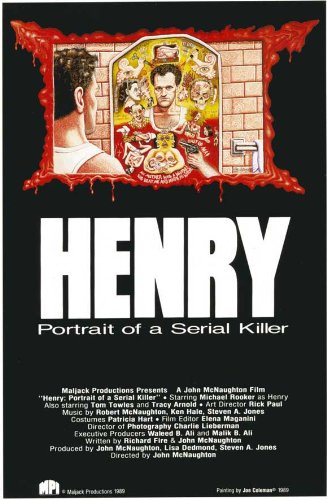 Back in the mid-1980s first time director John McNaughton was given a $100,000 budget by Maljack Productions (an early incarnation of MPI Video) to make a horror movie. McNaughton ended up directing, co-producing and scripting the movie, entitled HENRY: PORTRAIT OF A SERIAL KILLER and inspired by a TV profile of the infamous mass murderer Henry Lee Lucas.
Back in the mid-1980s first time director John McNaughton was given a $100,000 budget by Maljack Productions (an early incarnation of MPI Video) to make a horror movie. McNaughton ended up directing, co-producing and scripting the movie, entitled HENRY: PORTRAIT OF A SERIAL KILLER and inspired by a TV profile of the infamous mass murderer Henry Lee Lucas.
Serial killer biopics are a dime a dozen these days, but in 1986 there was nothing quite like HENRY and it was shelved by its backers until 1989 (distribution troubles have continued to plague McNaughton, particularly on his subsequent films THE BORROWER and NORMAL LIFE). After playing at the ’89 Telluride Film Festival, where it was highly touted by filmmaker Errol Morris, HENRY became a minor sensation, attracting many admiring notices…and a fair amount of controversy (see the 1994 Italian film CIAO DIARIO, which contains a fantasy scene in which its protagonist tortures a film critic who dared give HENRY a rave review). The MPAA infamously slapped it with an X rating for “overall tone”, which only attracted more attention.
The MPAA infamously slapped it with an X rating for “overall tone”, which only attracted more attention.
HENRY proved quite successful, and not a little influential—KILLER, CONFESSIONS OF A SERIAL KILLER, SOMBRE and KILLER ME are just a few of the innumerable HENRY wannabes that followed in McNaughton’s wake. In addition, at least three of HENRY’S participants have gone onto illustrious careers in Hollywood: lead actor Michael Rooker (who went onto appear in CLIFFHANGER, DAYS OF THUNDER, MALLRATS and many others), co-star Tom Towles (whose post-HENRY resume includes appearances in THE DEVIL’S REJECTS and McNaughton’s own NORMAL LIFE) and McNaughton himself (who later directed high profilers like MAD DOG AND GLORY and WILD THINGS).
Henry, an amoral serial killer, shows up at the Chicago home of his drug dealing buddy Otis one day, having murdered several women in various locations. Coincidentally, Otis’ sister Becky, on the run from an abusive husband, arrives at her brother’s home around the same time. From the start the dynamic between the three is an uneasy one, with both Henry and Otis taking an interest in Becky.
One night Henry and Otis hit the town and pick up two prostitutes who Henry, in a fit of passion, brutally murders. Otis is understandably shocked by his friend’s behavior, but strangely fascinated nonetheless. The following night Henry and Otis show up at the warehouse of a shady TV salesman, who Henry kills after the salesman mouths off to them. Next they head to a freeway underpass, where Henry formally inducts Otis into the world of mass murder by encouraging him to gun down a stopped motorist. Thus inducted, Otis enthusiastically joins Henry in breaking into the home of a suburban couple and massacring them and their young son, videotaping the whole thing and then eagerly watching it back home. Eventually Otis really goes over the edge; he rapes Becky and nearly strangles her to death, but Henry, who still bears a vestige of morality despite his murderous doings, bursts in just in time to save Becky and kill Otis.
This leaves Henry and Becky, who appear ready to embark on a star crossed relationship. They flee Otis’ home and hit the road, but the next morning Henry is seen exiting a cheap roadside hotel by himself…and leaving a heavy suitcase at the side of the road.
What powers HENRY are the interrelationships between its protagonists, all of them compelling, fully-drawn characters played by three very capable actors. Michael Rooker’s deeply menacing yet strangely charismatic performance in the title role has attained legendary status, and with good reason. Tom Towles is equally fine as his buddy Otis, whose descent into mass murder provides the film’s true horror, and Tracy Arnold adeptly essays the moral center of a film that ultimately plays more like a dark character piece than a traditional splatter fest (unlike most flicks of this type, the narrative doesn’t hinge on a police inquest).
What powers HENRY are the interrelationships between its protagonists, all of them compelling, fully-drawn characters played by three very capable actors.
It also helps that the film i’s superbly made. Sure, the ultra-low budget is often glaringly apparent, but McNaughton directs with an extremely deft, sure hand, boasting a tight, psychologically astute script and an admirably concentrated 83-minute running time. The end result is an unflinching, non-judgmental glimpse into the void that, far from “taking us into the mind” of its sociopathic title character (an early confessional scene, where Henry confesses to killing his mother but can’t seem to keep track of the how or why, suggests there may not be much of a mind to take us into), unveils a starkly amoral universe where human life means nothing. This makes for a profoundly disturbing film, certainly, but also an unusually brave and honest peek into the darkest corners of human nature.
Vital Statistics
HENRY: PORTRAIT OF A SERIAL KILLER
Maljack Productions
Director: John McNaughton
Producers: John McNaughton, Lisa Dedmond, Steven A. Jones
Screenplay: Richard Fire, John McNaughton
Cinematography: Charlie Lieberman
Editing: Elena Maganini
Cast: Michael Rooker, Tom Towles, Tracy Arnold, Lisa Temple, Brian Graham, Sean Ores, Waleed B. Ali, Donna Dunlap, Kurt Naebig, David Katz, Eric Young, Lily Monkus, Ray Atherton
